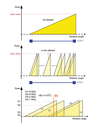issue contents
September 2021 issue
Includes papers presented at the 11th International Workshop on X-ray Radiation Damage to Biological Crystalline Samples
14–16th October 2020 (online)

Cover illustration: Artistic rendering of the photolysis of an engineered protein disulfide bond in solution by incident X-rays (see Stachowski, Snell and Snell, pages 1309–1320). This method allows perturbations to high-resolution structural features to be studied with SAXS, a low-resolution technique, by connecting these changes to observable large-scale transitions. Protein rendered with Illustrate [Goodsell, D. S., Autin, L. & Olson, A. J. (2019). Structure, 27, 1716–1720].
facility information
editorial
Open  access
access
 access
accessDiscussing JSR's forthcoming transition to open access.
scientific commentaries
Open  access
access
 access
accessExtremely bright synchrotron radiation sources give extremely strong intensities at the sample. Lawrence Bright et al. (2021) [J. Synchrotron Rad. (2021), 28, 1377–1385] dive into the details for materials science. I offer a Commentary including a historical context.
radiation damage
Open  access
access
 access
accessAn understanding of radiation damage effects suffered by biological samples during structural analysis using both X-rays and electrons is pivotal to obtain reliable molecular models of imaged molecules. This special issue on radiation damage contains six papers reporting analyses of damage from a range of biophysical imaging techniques.
Open  access
access
 access
accessA guideline for de novo phasing with small-wedge synchrotron crystallography data collection is presented based on systematic investigations of dose and number of merged sub-datasets.
Open  access
access
 access
accessThis radiation damage study uses a hybrid approach combining molecular dynamics with non-thermal plasma simulations to follow the femtosecond dynamics and X-ray scattering from a protic ionic liquid as it is investigated by an intense XFEL pulse.
Open  access
access
 access
accessA system engineered to produce a large-scale structural change from X-ray-induced disulfide bond cleavage allows residue-specific changes to be interpreted with SAXS. This system is used to investigate how radical scavengers reduce bond breakage during data collection at 10°C with the results providing insight into mitigation strategies for crystallographic and solution experiments.
The design of a new high-throughput X-ray footprinting endstation and its application to footprinting experimental optimization is described.
Open  access
access
 access
accessThe method of X-ray footprinting mass spectrometry was used to investigate the effect of X-ray irradiation on various proteins in solution under both fully aerated and low dissolved oxygen conditions, and as a function of protein concentration.
Open  access
access
 access
accessAlternative single-particle cryo-EM schemes are reviewed, in order to improve dose efficiency for obtaining more or complementary structure information within the limited lifetime of the sample.
photondiag2020 workshop
Open  access
access
 access
accessSimulation results for dynamic ray-tracing software are compared with experimental data showing the impact of vibrations on sample-point X-ray beams.
The design of an angular array of electron time-of-flight spectrometers is reported, intended for non-invasive spectral, temporal, and polarization characterization of single shots of high-repetition rate, quasi-continuous, short-wavelength free-electron lasers such as the LCLS II at SLAC.
research papers
Open  access
access
 access
accessThe high levels of flux available at a fourth-generation synchrotron are shown to have significant beam heating effects for high-energy X-rays and hard condensed matter samples, leading to temperature increases of over 400 K with a monochromatic beam.
Open  access
access
 access
accessThe development of automated sample delivery and drop on demand methods is described.
Open  access
access
 access
accessThe unique parameters of the European XFEL enable novel and groundbreaking experiments in matter at extreme conditions at the High Energy Density (HED) scientific instrument. The performance of the HED instrument during its first two years of operation, its scientific remit, as well as ongoing installations towards full operation are presented.
A description of the upgraded bunch-by-bunch feedback system for time-resolved experiments at Pohang Light Source II (PLS-II) is provided. The project is part of the SPring-8 and PLS-II collaboration.
Here, finite-element analysis is used to study the thermal deformation of a multilayer mirror due to the heat load from the undulator beam at a low-emittance synchrotron source. The energy bandwidth of the double-multilayer monochromator is larger than that of the relevant undulator harmonic, such that a considerable portion of the heat load is reflected. Optimizing the substrate geometry without considering the reflected heat load yields an incorrect depth of the `smart cut' and significant thermal bending.
This research provides a method of designing reflective extreme ultraviolet (EUV) phase retarders using a linearly chirped Mo/Si multilayer mirror, which can achieve phase control and polarization state analysis of EUV synchrotron radiation.
This work presents the first characterization of a thin organic semiconductor photodiode for dosimetry in microbeam radiation therapy carried out on the Australian Synchrotron Imaging and Medical Beamline.
Exploitation of X-ray circular polarized beams to study forbidden Bragg reflections and new information that could be obtained in these experiments are discussed.
The dynamical theory of X-ray Laue diffraction in flat and wedge sectioned multilayers is considered. Recurrence relations are obtained that describe Laue diffraction in structures that are inhomogeneous in depth.
The first X-ray Extended Range Technique (XERT)-like experiment at the Australian Synchrotron measured 496 energies from 8.51 keV to 11.59 keV for zinc metal to 0.023–0.036% accuracy. Systematics are quantified.
Zinc metal XAFS to high accuracy determined K-edge jump ratio and jump factors, revealing significant issues in theory and experiment. Nanostructure of zinc is determined to high accuracy with bond lengths with uncertainties from 0.1% to 0.3% or 0.003 to 0.008 ÅA, suggesting local dynamic motion of the crystal lattice.
Sputter deposition is combined with in situ N K-edge absorption measurements to study thin films of magnetic nitrides (Fe-N, Co-N, Ni-N) ranging from sub-monolayer to bulk. Ultra-thin films of these nitrides were found to demonstrate a different behavior that can be coupled with structural changes taking place with the increasing film thickness.
This article evaluates the utility of pre-edge analysis of X-ray absorption near-edge structure spectra for studying materials with variable amounts of disorder using two examples: a unimodal distribution of nearest neighbors of homogeneously distributed metal centers (Ti in Ti oxide nanocomposites) and a bimodal distribution due to the local structural heterogeneities around V in V oxide nanocomposites. In the latter case, both the pre-edge analysis and conventional EXAFS analysis are combined to detect the presence of local structural heterogeneities.
Open  access
access
 access
accessThe local chemical state of a model Pt/Al2O3 catalyst is visualized operando by rapid 2D XANES imaging during the catalytic partial oxidation of methane to synthesis gas.
Open  access
access
 access
accessBeam stability and sample drift compensation schemes are presented for use on I14, the Hard X-ray Nanoprobe at Diamond Light Source.
Nuclear resonant reflectivity (NRR) was measured from an Fe60Al40 film irradiated by 20 keV Ne+ ions with gradually varying fluences of 0–3.0 × 1014 ions cm−2. The evolution of the ferromagnetic onset, starting from the central part of the film and propagating towards the interfaces, was revealed by the fit of the NRR time spectra.
The temperature and wavenumber dependence of the EXAFS oscillation of hexagonal close-packed crystals have been calculated and analyzed under the effect of the non-ideal axial ratio c/a based on the extended anharmonic correlated Debye model.
A feasible implementation of a novel X-ray detector for highly energetic X-ray photons with a large solid angle coverage, optimal for the detection of Compton X-ray scattered photons, is described. The device, consisting of a 20 cm-thick sensitive volume filled with xenon at atmospheric pressure, forms photoelectron images by resorting to the electroluminescence produced in a custom-made multi-hole acrylic structure.
Open  access
access
 access
accessIn an off-axis geometry, a circular multilayer zone disc is used to locally generate X-ray beam induced currents inside a single InP nanowire. This allows to spatially probe local electric fields at practical working distances and very low background signal.
Open  access
access
 access
accessDissimilar hardware and software conventions at various synchrotrons lead to quantitative differences in experimental results. This paper proposes a method to improve reproducibility of tomographic reconstructions by optimizing the filtering step in commonly used reconstruction algorithms.
A practical step-by-step guide to high-speed X-ray computed tomography is presented, from the collection of computed tomography images and their reconstruction to performing quantitative analysis, while accounting for the constraints imposed by high-pressure and high-temperature experimentation.
short communications
A ptychographic coherent diffraction imaging (CDI) system with pinhole or Fresnel zone-plate optics for use in the tender X-ray region (2–5 keV) has been developed on the BL27SU beamline at SPring-8. A resolution of approximately 50 nm was achieved in ptychographic CDI of a 200 nm thick Ta test chart, and a sulfur polymer material was successfully observed.
A correlation-based semi-synthetic computational optical approach has been applied to assess the possibilities of exploiting the spatio-spectral aberrations of the Infrared Microspectroscopy Beamline to perform rapid imaging.
beamlines
Open  access
access
 access
accessThe performance of the new Finnish–Estonian Beamline for Atmospheric and Materials Sciences is characterized and discussed.
A new experimental station has been developed at BL25SU of SPring-8 for angle-resolved photoemission spectroscopy using a soft X-ray microbeam.
The commissioning and first experiments on the white beam imaging facility at the imaging beamline Indus-2 to allow high-resolution imaging at high frame rates and higher penetration are presented.
Robotic sample changers for macromolecular crystallography and biological small-angle X-ray scattering are presented.
The Brain Imaging Beamline (BIB) of the Taiwan Photon Source (TPS) and its endstation, designed to take advantage of bright unmonochromatized synchrotron X-rays and targeting fast 3D imaging and high spatial resolution, have been commissioned and opened to users.
laboratory notes
A wide-acceptance-angle spherical grid with numerous micro cylindrical holes was developed for a high-resolution retarding field analyzer.


 journal menu
journal menu






























































